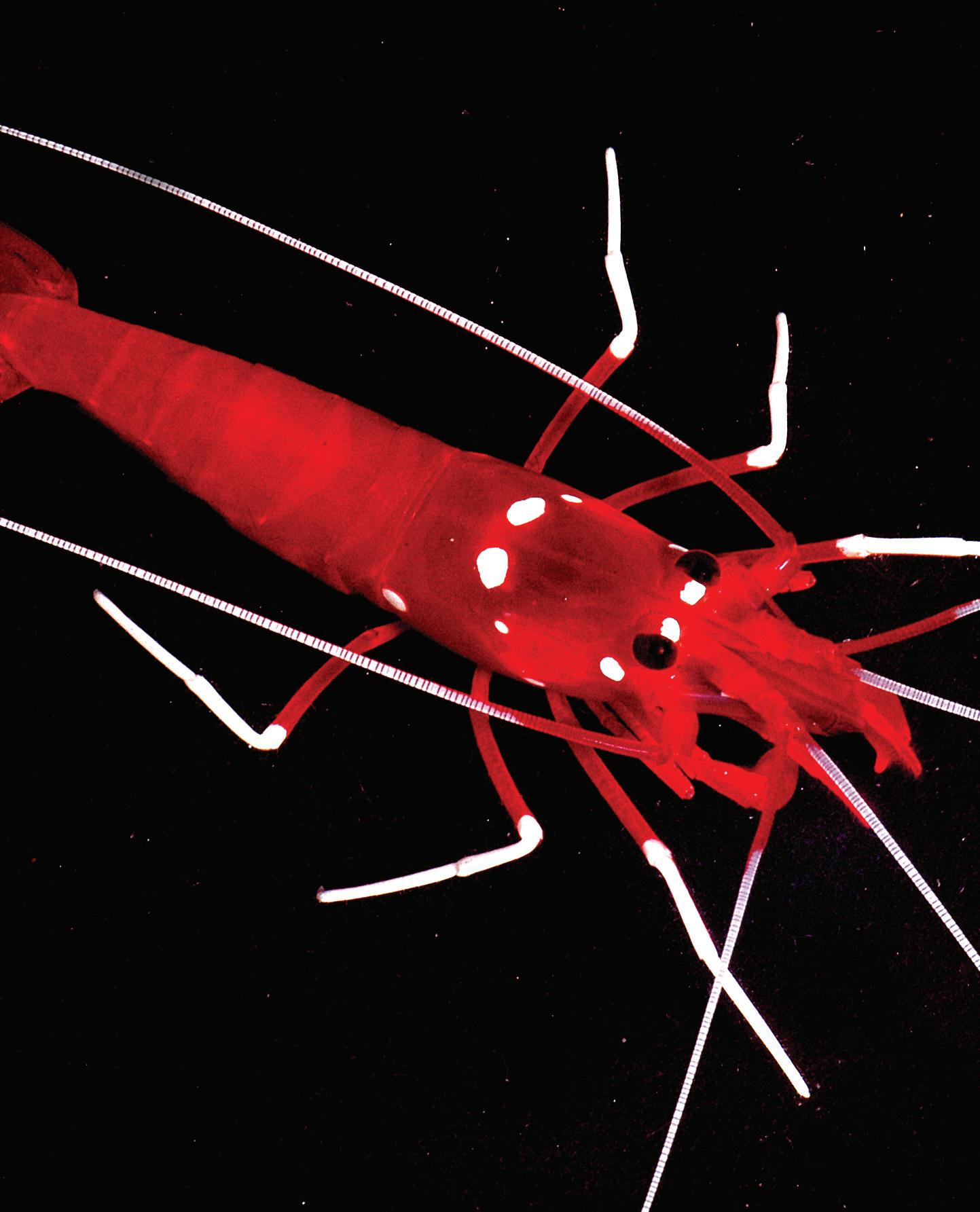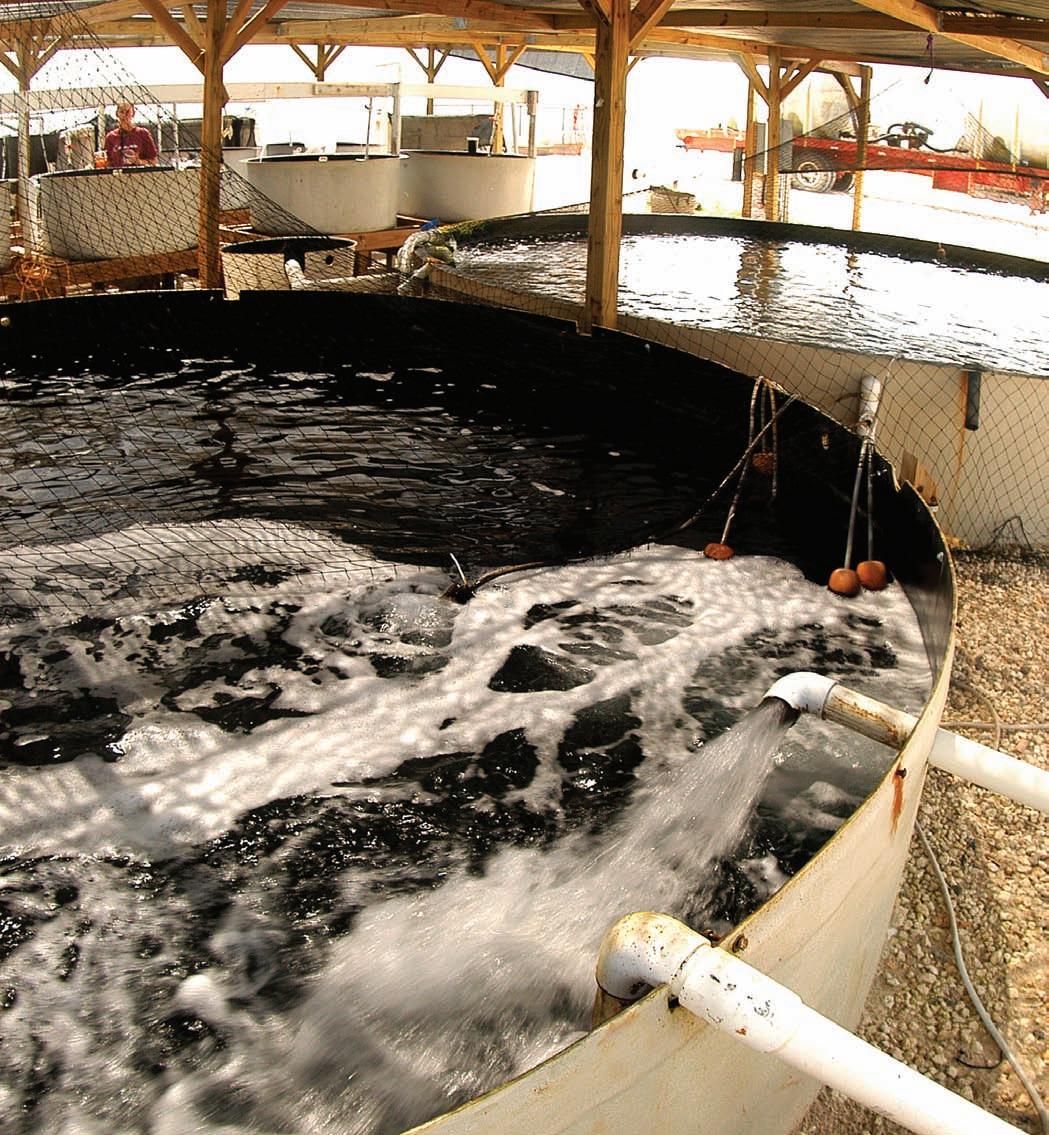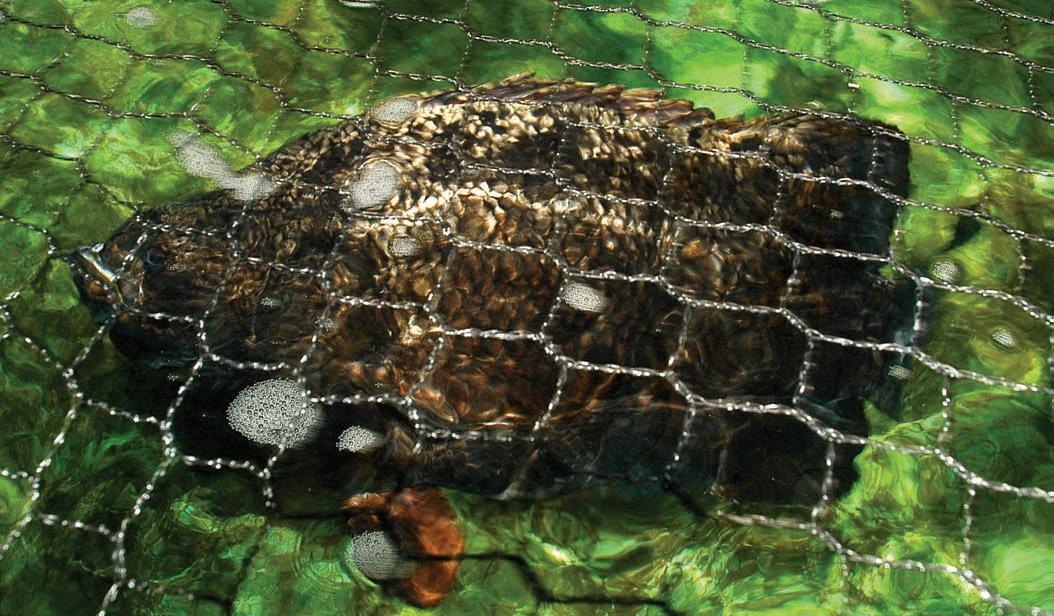Once a local outpost in our defense against nuclear war, it now seeks to protect sea life from nuclear plants.
The Underwater Labs Of Dr. Lin


Once a local outpost in our defense against nuclear war, it now seeks to protect sea life from nuclear plants.

For more than 20 years, researchers and students from the Florida Institute of Technology in Melbourne have been conducting a number of marine science experiments in Vero Beach. Inside two tan buildings that once belonged to the Air Force, researchers are growing algae-eating crabs, hermaphroditic shrimp and bizarre-looking crustaceans that dine on innocent starfish. And yet, many Vero Beach residents don’t even know that this facility exists.

It’s not that the staff at the Vero Beach Marine Laboratory has been toiling under a cloak of secrecy. In fact, it’s the opposite; the staff has been working quite openly on producing better aquaculture products for both aquariums and consumption. Lab Director Dr. Junda Lin routinely shares his staff’s work with other educational institutions, research centers and aquaculture facilities. It’s just that most Vero Beach residents have never noticed the lab, which is located in an inauspicious location next to Tracking Station Park off A1A about two miles north of Beachland Boulevard.
“People couldn’t even see us from the beach before the hurricanes because the dunes were so high,” says Andy Rhyne, a Ph.D. student who works at the lab. In 2004 that changed. Hurricanes
Frances and Jeanne washed away nearly 75 feet of sand and dunes
that buffered the research center from the public beach. After the storms beachgoers had a direct view of the buildings and various outdoor tanks that make up the lab. Fencing had to be erected to keep people from using the lab as a beach access.
The black chain-link fence wasn’t installed to hide the facility, only to protect the public from falling into a hole or tripping over a hose. One
night after the hurricanes, the power had yet to be restored and some teenagers inadvertently were walking through the site trying to get to the beach. The staff just happened to be outside with flashlights and helped them find their way.
Safety is a concern for the FIT staff. In addition to the vast number of hoses and power cords that crisscross the property, a small bunker
house goes down several stories to a series of underground cables that were once used to track submarines, and connect the lab to the Bahamas.
“We have to be careful. We don’t want anybody to get hurt,” says Dr. Lin.
Other than the crafty raccoons, who often break into the outdoor tanks and steal a meal or two, Lin says the facility has never had a problem

with intruders. The nocturnal bandits have become so crafty, Rhyne adds, they have even learned how to turn off the pumps, causing the fish to go to the top of tanks where they can more easily be yanked out.
The marine lab was born when the Cold War cooled and the United States Air Force decided to retire its 10-acre
tracking station in Vero Beach. In 1981, six of the acres were handed over to Indian River County to create a public beach access; the other four acres were donated to FIT. All of the buildings on the 4,500-square-foot FIT property, which comprises a small guard house, a two-story radar tower and a one-story office building, were part of the original Air Force base. The

college didn’t add any structures to the site except for several outdoor tanks that are partially covered with pavilion-like wood frames and black mesh tarps. The main building was converted into wet and dry labs, offices for Dr. Lin and his staff and a medium-size conference/classroom. The two-story hex building that had been the radar tower was converted into a loft/laboratory that

houses flow-through and recirculation tank systems. Inside the first floor are several chest-height tanks, but as you walk up the wooden spiral stairs you’re surrounded by dozens of smaller fish tanks, white fivegallon buckets, hoses and funnel-like plastic containers all containing salt water direct from the Atlantic.
Partially funded by the National Oceanic and Atmospheric Administration and the U.S. Department of Commerce, the focus of the marine lab is to investigate various aspects of aquaculture, mainly focusing on the kind of ornamental species that are sold to aquariums and pet stores.

While the facility might not be much to look at from the outside, Lin and his staff couldn’t be happier with it. “Our location is ideal because we have an unlimited supply of ocean water,” Lin explains. “Very few labs have ocean access like this.”
Three pumps generate as much as 300 gallons per minute into the various tanks on the lab’s property. All the water is drawn from the ocean with pipes buried at least seven feet under the sand. There is a large discharge tank 10 to 15 feet below the surface to allow the water to be filtered before being slowly released back into the Atlantic.
In addition to drawing its own salt water for both the Melbourne campus and the Vero Beach lab, FIT supplies salt water to a number of organizations, including NOAA’s Coastal Services Center in Charleston, S.C.
The damage from three hurricanes in two years created some setbacks for Dr. Lin’s staff. In addition to the loss of the dunes, the greenhouses and pump houses were completely destroyed and all the tank systems were badly damaged. A hatch on the top of the radar tower blew off during one of the storms and dumped 24 hours’ worth of sand and rain
into the lab. However, the 18-inchthick concrete walls held up during all three of the hurricanes.
Today, the staff has replaced and repaired nearly all of the damage and continues with their work. They have also begun several new research projects. Inside one empty office in the main building, several small television monitors are connected to video cameras inside two four-footdeep swimming pools. The pools, 24 feet in diameter, are your typical backyard, above-ground swimming pools, except that these are installed with cameras that monitor various ways of keeping marine animals from getting caught in intake pipes at nuclear power plants.
“We’re working on that project now, using sound, light and maybe chemicals to avoid marine life being caught in the pipes,” Lin explains.
Billed as the first major effort to
address the problem in the 32-year history of the Clean Water Act, the Environmental Protection Agency’s Regulation 316(b) will require nuclear power plants to withdraw more than 50 million gallons of water a day to meet new performance standards aimed at reducing the number of fish pinned against intake screens by up to 95 percent.
Also, certain facilities will have to achieve a 60 to 90 percent reduction in the number of tiny organisms small enough to slip through the screens. EPA officials believe this new measure could save up to $80 million a year by enhancing recreational and commercial fishing. It will also protect more than 200 million pounds of fish and other aquatic organisms from being drawn into heavy currents and/or banged up against intake screens or drawn through a plant’s cooling system.
“The new law doesn’t take effect until 2008, but everyone has to have a plan in place to reduce the intake, so we’re excited to help them with
that,” Dr. Lin says.
Lin and his staff have also been working with live snook inside the swimming pools, monitoring their
reactions to various lights and sounds. The controlled environment allows the lab researchers to control the speed and flow of the water inside

the pools to test a variety of conditions. The video system records all movement in the swimming pools, and researchers can even check the monitors over the Internet so they don’t have to constantly be in attendance at the lab.
The main focus at the lab has always been on aquaculture. The Florida Department of Agriculture & Consumer Services reports that the Sunshine State ranks third in total U.S. aquaculture sales, with farmers growing everything from aquatic plants to alligators. In a 2003 survey, Florida aquaculture producers reported sales of $95.5 million, with nearly 50 percent of those sales coming from tropical or ornamental species.
The bulk of tropical fish production in Florida is centered in west central counties such as Hillsborough and Polk, which make up almost 62 percent of sales. Another 22 percent of the farms are located in east coast counties from Brevard to MiamiDade.
Most of the aquaculture operations in Florida are small. Of the 544 operations surveyed in 2003, nearly 44 percent are less than three acres in size. These represent many of the clam producers, who lease two acres of water in the Indian River Lagoon or Gulf of Mexico, as well as some small tropical fish farms. Another 20.6 percent of the operations use between three and six acres of land and/or water. Only three percent of the operations use 50 acres or more.
“Aquaculture in this country is tough,” admits Dr. Lin. “The environmental and economic costs are the biggest drawbacks.”
Lin, who spent three years working on his Ph.D. at the University
of North Carolina’s Chapel Hill Marine Lab, joined the FIT staff in Melbourne as a professor of biological sciences in 1991. He believes Florida is the perfect place to grow ornamental species “because of the warm weather and water quality.” By growing ornamental species on farms, researchers hope to reduce the impact to the ocean’s reefs, especially those in the Pacific, which are being damaged by ornamental fishermen.
Andy Rhyne is one of the FIT students who spends most of his days at the Vero Beach lab, where he helps look after the variety of marine ornamentals inside the old radar tower. Dimly lit and humid, the bottom floor houses a number of large 5,000-gallon tanks, while the second floor is lined with dozens of small 10-gallon tanks. Inside are thumb nail-sized crabs and cleaner shrimp that feed off algae. You may recall that cleaner shrimp were made popular by the

Disney/Pixar film Finding Nemo, which featured a French-accented shrimp named Jacque.
Rhyne also works with a species of shrimp that is both male and female. And then there are the peppermint shrimp, not so named because of their taste but because of their look.
Though the tanks harbor mostly crustaceans, there are also a few species of finfish because Rhyne finds them “fun to work with.”
While many of the species being grown in the hex lab could easily be sold to aquariums and pet stores, they are not for sale.
“We do not sell our products as we’re partially funded by government grants,” explains Dr. Lin.
“Also, our focus is to figure out culture technology and disseminate the information widely in publications,
so that companies can use the data to produce the species.”
You can find some of Lin’s shrimp at the St. Lucie County Marine Center, a public aquarium on South Hutchinson Island featuring more than 8,000 gallons of marine tanks that replicate the Indian River Lagoon. The center’s touch tanks feature peppermint shrimp that were grown in the Vero Beach lab. The tiny crustaceans are housed in a floating basket, and if you place your fingertips in the water they swim to the top and give you a free manicure.
Another group that benefits from FIT’s research is Maritech. Through a cooperative agreement with the college, Maritech occupies office space inside the Vero Beach lab’s main building and has at least two full-time staff members on site. Maritech’s main focus—developing new species of ornamental fish—was
greatly reduced after the 2004-2005 hurricanes, but the company continues to develop ways to grow food fish species native to Florida waters.

While the Maritech staff is reluctant to share their findings with competitors and the press, Dr. Lin says they enjoy a great partnership with FIT—“It helps expose our students to the real world.” Though FIT is one of the few colleges in the country that offers a bachelor’s degree in aquaculture, many students end up working for Maritech full-time or as interns on various projects.
Another major project, says Dr. Lin, is convincing state and federal regulators to create the country’s first designated offshore aquacultural zone off the coast of Florida. The current annual trade deficit in the U.S. for seafood is running around $9.3 billion. Because natural fish populations are already being
harvested at or above their sustainable limits, Lin and others believe that the only way to make up the deficit is through aquaculture. The production of aquaculture finfish is currently dominated by lower-value freshwater species (carp and tilapia) and coldwater species (salmon). Yet, Lin says, the fastest growing and highest value food fish species thrive in warm marine waters like those found off Florida’s shores, especially near the Treasure Coast.
For more than two years now, a Florida-owned hatchery has been stocking Florida pompano into large underwater net pens in the Bahamas, where offshore cage farming is allowed. One of the highest-priced food fish in the U.S., pompano is a native species in the western Atlantic and Caribbean islands. Cobia, another fastgrowing species, is also being raised in underwater, offshore pens in the
Caribbean with great success. These cages are anchored as deep as 90 feet below the surface, where more than 500 million gallons of water flow through the cages each day.
Because these species are fastgrowing, high-value fish, Lin says, the creation of an offshore aquaculture zone in the United States’ Exclusive Economic Zone (3.4 million square miles located between three and 200 miles off our coast) would create a huge economic boom to the state’s aquaculture industry.

“The cages have a great track record,” he says. “As they say, ‘Dilution is the solution to pollution.’”
Proponents are concerned that these offshore cages will have harmful environmental impacts on other marine life, such as sea turtles and dolphins. There are also those who worry about disease affecting large numbers of these cage-raised fish, hurting the seafood industry. And then there are those traditional

fishermen who worry about their livelihood.
But Dr. Lin and others see these offshore cage farms as a viable alternative to taking up expensive coastal property for fish farming and as an environmentally friendly way to restock fish populations and the seafood lover’s appetite.
“I’m really hoping we can break ground on cage farming,” he says. “It would be very good for Florida’s aquaculture industry.”
Having grown up in China, a country that accounts for two-thirds of the world’s aquaculture, Lin has always been fascinated with the subject. And now that folks in Vero Beach can actually see the marine lab, the doctor is hoping he will be able get more people interested in aquaculture’s promise for the future—especially, of course, those all-important state and federal regulators. `